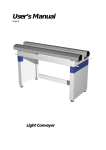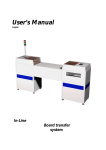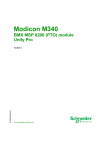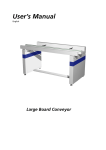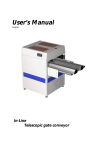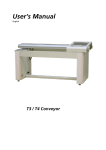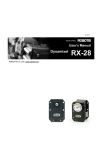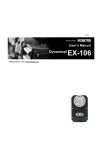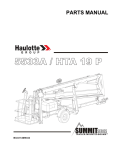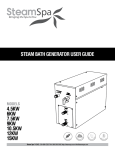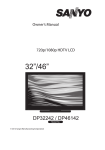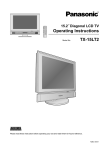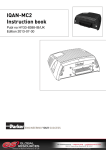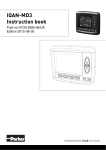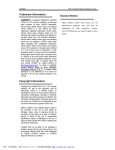Download User`s Manual - Silgal
Transcript
User’s Manual English In-Line Light Manual Loader Light Manual Unloader Light Manual Reloader User´s Manual This manual is intended for the inline device specified on the previous page. The manual contains information to assist the operator to start and operate the device properly, and to maintain it. Hardware and software mentioned in this document are subjected to continuous development and improvement. Consequently, there may be minor discrepancies between the information in the document and the performance and design of the hardware and software. Specifications, dimensions and other statements mentioned in this document are subject to change without prior notice. Conventions In this manual angle brackets <> are used to indicate certain button names. Example: <Enter> stands for the ENTER button. The manufacturer and its suppliers shall not be liable for any damages related to the software or hardware, or for any other damages whatsoever caused by the use of, or inability to use any manufacturers product. This is applicable even if the manufacturer has been advised of the damage risk. Under any circumstances, the manufacturer’s entire liability shall be limited to replace such defective software or hardware, which was originally purchased from the manufacturer. Printed in Sweden. LC810_040928u.doc II User´s Manual Contents 1. SAFETY ................................................................................................. 1 Emergency stop button.............................................................................................. 2 Emergency movement of machine elements .............................................................. 2 Warning signs ........................................................................................................... 3 Warnings................................................................................................................... 4 2. INSTALLATION ...................................................................................... 5 Site preparation ......................................................................................................... 5 Power supply requirements........................................................................................ 5 Environmental requirements ..................................................................................... 6 Lifting information.................................................................................................... 6 Installation................................................................................................................ 7 3. PRODUCT DESCRIPTION......................................................................... 8 Main parts................................................................................................................. 9 General function ..................................................................................................... 10 Control panel .......................................................................................................... 12 Operation modes ..................................................................................................... 13 Automatic mode...................................................................................................... 14 Hand mode ............................................................................................................. 16 Option menu........................................................................................................... 17 Setup mode ............................................................................................................. 18 Alarms and messages ............................................................................................... 23 Signal tower............................................................................................................. 25 4. OPERATION SETUP................................................................................ 26 Setting up the machine for operation....................................................................... 26 5. MAINTENANCE .................................................................................... 31 Lubricant specifications ........................................................................................... 33 Figures Figure Figure Figure Figure Figure Figure Figure 1-1 Electric shock ............................................................................................... 3 1-2 Moving parts, risk of injury........................................................................... 3 1-3 Attention...................................................................................................... 4 3-1 Loader/Unloader/Reloader main parts........................................................... 9 3-2 Control panel ............................................................................................. 12 3-3 Signal tower................................................................................................ 25 5-1 Lubrication................................................................................................. 32 LC810_040928u.doc III User´s Manual 1. Safety Before starting the machine, it is necessary that the operator, foreman, and any other personnel involved in the machine operation, maintenance or service understand and obey the following: LC810_040928u.doc • Trained personnel must operate the machine only. • Anyone operating this machine must obey all warning signs. • All personnel involved in machine operation must understand the use of the emergency stop button and how to move machine elements in case of emergency. See the following sections entitled Emergency Stop Buttons and Emergency Movement of Machine Elements in this chapter. • Apart from weekly maintenance described in Chapter 5, Maintenance, the machine is to be serviced by authorised personnel only. • No hands or fingers are allowed in the vicinity of moving parts. • Ensure that all covers and shields are intact, mounted and closed while the machine is in operation. • Do not disable or disengage any safety switches or sensors. • Do not use chemicals or other substances that may have any influence on the operator or other personnel involved in machine operation. 1 User´s Manual Emergency stop button There is an emergency stop button located at the cabinet, to the left of the control panel. The emergency stop button is red and stops all machine movements immediately when pressed down. The button is released by being pulled up and/or turned counter-clockwise. The emergency stop button must always be pressed down when hands, fingers, tools or other objects are in the risk area of movable machine elements. Restart To restart the machine after an emergency stop: 1. Release the emergency stop button by pulling it up or turning it counter-clockwise. 2. Start the operation as normal. Emergency movement of machine elements The elevator unit cannot be moved by hand. If an accident has occurred and an emergency movement of the elevator unit is required, use the following procedure: LC810_040928u.doc 1. Leave the power on. Do NOT turn off the main power switch. 2. Pull up the emergency stop button, if pressed down. 3. Press <F2> ‘Hand’> in Main menu to enter Hand mode. 4. Use buttons <F2> ‘↑ ’ and <F3> ‘↓ ’ to move the elevator. 2 User´s Manual Warning signs The warning signs on the machine must be observed as this machine contains moving and electrically live parts. All signs must be kept clean and readable. If a sign is missing, it must be replaced immediately. Electric shock The sign warns of electric shock. Units on which this sign is placed contain dangerous voltage levels. Power must be switched off before opening the unit. Only authorised service personnel are allowed to operate the machine when the unit is open. Figure 1-1 Electric shock This sign is applied as follows on the machine: • One sign on the cabinet door Moving parts, risk of injury The sign warns of moving machine parts. If this sign is placed on the machine, there is a risk of injury if any body part is near moving parts. Power must be switched off before service or maintenance. Figure 1-2 Moving parts, risk of injury This sign is applied as follows on the machine: • One sign on each side of the elevator unit LC810_040928u.doc 3 User´s Manual Warnings Attention Throughout the manual, this symbol is used to call your attention to commands that starts machine movements or other events that need special attention. The symbol often refers to the warning signs, which must be obeyed to eliminate the risk of injury. If there are instructions accompanying this symbol, they must be followed. Figure 1-3 Attention LC810_040928u.doc 4 User´s Manual 2. Installation The machine is delivered on a pallet: Before unpacking the machine, make sure that the site is prepared as described below. Then, unpack and position the machine on the site. Lift and weight information is found below. When the machine is located on its site, install it as described last in this chapter. Site preparation Prior to installing the machine, ensure that there is electric power and compressed air available on the site, see the requirements below. Make sure the environmental conditions meet the requirements specified below. Note that it must be a free space of at least one meter around the machine, except for other devices and machines included in the conveyor line. Power supply requirements Voltage Supply voltage: Voltage tolerance: Frequency: Power consumption: 100-240 VAC ±10% 50/60Hz 900 Watt maximum Compressed air The compressed air must be dry and clean. Pressure: Largest particle size: LC810_040928u.doc 6 bar 5 micron 5 User´s Manual Environmental requirements Temperature Operating: Storage: +5 to +40°C (41 to 104°F) –40 to +60°C (-40 to 140°F) Relative humidity Operating: Storage: <95%, non condensing 100% Dust and dirt The machine does not require a clean-room environment but the level of dust and dirt must be kept as low as possible. The maintenance intervals are shortened by high temperature and dusty or dirty environment. Lifting information The machine can be lifted with a forklift truck, if some wooden boards are put between the forks and the framework. Weights Loader: Unloader: Reloader: LC810_040928u.doc 90 kg 90 kg 90 kg 6 User´s Manual Installation The installation must be carried out by authorised service personnel. Placing the unit Ensure that the floor is sturdy. Place the machine on its site. To be able to install, maintain and service the machine, there must be a free space of at least one meter around it, except for other devices and machines included in the conveyor line. Levelling Level the complete line carefully along the conveyor belts. Let the pusher determine the height of the machine when adjusting levelling feet. Use a spirit level across and along the elevator plate and adjust the feet of the machine. The machine must stay steady on all feet when the adjustment is finished. Mains supply Mains supply is to be connected by an authorised electrician. The internal power supply can be adapted to two different mains voltage levels, 115 or 230 VAC. Use the selector switch on the front of the power supply to select correct setting according to available mains voltage. Disconnect mains supply using the main switch before changing selector switch position. LC810_040928u.doc 7 User´s Manual 3. Product Description This chapter describes the Loader/Unloader/Reloader. The description is divided into the following main sections: LC810_040928u.doc • Main parts of the machine, page 9. • General function, page 10. • Control panel and buttons in the panel, page 12. • Operation modes, page 13. • Alarms and messages, page 23. • Signal tower and buzzer, page 25. 8 User´s Manual Main parts A E B F C G D H I J K Figure 3-1 Loader/Unloader/Reloader main parts The following main parts are pointed out in the figure above, by the letters. Main parts A. Control panel B. Emergency stop C. Main power switch D. Elevator unit E. Pusher guide F. Pusher cylinder G. Pusher arm H. PCB release sensor (Unloader/Reloader) I. Pusher PCB grip (Unloader/Reloader) J. Elevator guide K. Elevator lead screw LC810_040928u.doc 9 User´s Manual General function The Loader is designed to move printed circuit boards from a PCB cassette to a board conveyor in a PCB assembly inline system. The Unloader is designed to move printed circuit boards the other way round, i.e. from a board conveyor back to a PCB cassette. The Reloader is designed to move printed circuit boards from a PCB cassette to a two-way board conveyor in a PCB assembly inline system, and receive the same board from the conveyor into the cassette slot it came from. The PCB cassette maximum size is 570mm (H) x 580mm (W) x 535mm (D). Letters within brackets in the following description refer to the main parts pointed out on the previous page. Loader A PCB cassette containing printed circuit boards is put on the elevator unit (D). The pusher arm (G) pushes the printed circuit boards out of the cassette one by one, onto/into the following machine. The elevator unit moves the cassette vertically to the correct level for each board to be pushed out. When the cassette is empty, the elevator unit moves it to a predefined cassette change level. Unloader If the Unloader is ready to receive a board, the pusher arm (G) is moved to its outermost position. When the preceding machine has a board available, the pusher PCB grip (I) grabs the board and the pusher arm (G) is retracted. During retraction the pusher arm (G) reaches the position of the PCB release sensor (H) where the board is released. When the pusher arm (G) is in its innermost position, the elevator unit moves the cassette vertically to the next level. When the cassette is full, the elevator unit moves it to a predefined cassette change level. LC810_040928u.doc 10 User´s Manual Reloader A PCB cassette containing printed circuit boards is put on the elevator unit (D). The pusher arm (G) pushes a printed circuit board out of a cassette slot, onto/into a two-way machine. The machine processes the board and makes it ready for transport back into the Reloader. When the preceding machine has a board available, the pusher PCB grip (I) grabs the board and the pusher arm (G) is retracted. During retraction the pusher arm (G) reaches the position of the PCB release sensor (H) where the board is released. When the pusher arm (G) is in its innermost position, the elevator unit moves the cassette vertically to the next level. When all boards in the cassette are processed, the elevator unit moves it to a predefined cassette change level. LC810_040928u.doc 11 User´s Manual Control panel Figure 3-2 Control panel General The machine is controlled from a control panel. The various display views and operation modes are described in the following sections. The control panel shown above, is located on the upper part of the control cabinet as shown on page 9. The control panel buttons are described below. Function Buttons <F1>...<F4>: Use these buttons to control the machine. The buttons have different functions depending on mode and display view. A text/symbol describing the function in current display view is shown above each button on the lower text row. Buttons are indicated by bold angle brackets < > and text in this manual. Example: <F1> Auto. Control Buttons < ↵ >: Also written as <Enter>, is used to enter password login in setup mode, to select setting options and to enter parameter values. < ← >: Erases the character to the left of the cursor when entering parameter values. LC810_040928u.doc 12 User´s Manual Numerical Buttons <NUM>: Hold this button while entering digits < 0...9 >. Use together with <NUM> to enter values. Finish with <Enter>. <- >: Press once for hyphen. Shifts between positive and negative values. < . >: Press twice rapidly for decimal point. Cursor Buttons (orange) < ù >and < ü >: Move cursor up or down. < ÿ >and < ÷ >: Move cursor to the previous or next option. Operation modes Powering up After completed initiation, a display view for home positioning is shown on the control panel. Home position « [OK] The operator can now execute a home positioning for the elevator unit by pressing <F4> ‘OK’, or skip home positioning by pressing <F1> ‘«’. Generally, a home positioning is not necessary, but if service or maintenance of the machine is done, a home positioning is strongly recommended to guarantee correct elevator positioning. This display view is not shown again until next power up, or if chosen from Hand menu. LC810_040928u.doc 13 User´s Manual Main menu To control the machine, the following operation modes can be selected from the Main menu. ----[ MAIN MENU ] ---Auto Hand Opt Setup • • • • Automatic mode Hand mode (Manual mode) Option menu Setup mode These operation modes are described in the following sections. Selecting operation mode You can select the desired operation mode from Main menu as follows: • • • • To To To To enter enter enter enter Automatic mode, press <F1> ‘Auto’. Hand mode, press <F2> ‘Hand’. Option menu, press <F3> ‘Opt’. Setup mode, press <F4> ‘Setup’. To exit the current operation mode and return to the main menu: • Press <F1> ‘«’ repeatedly, until Main menu is displayed on the control panel. In case of emergency, use the emergency stop button to stop the movement immediately. Automatic mode Automatic mode is used for production, i.e. to provide the production line with printed circuit boards (Loader) and to gather them up at the end of the line (Unloader), or both (Reloader). ----[ MAIN MENU ] ---Auto Hand Opt Setup Select Automatic mode by pressing <F1> ‘Auto’ in the Main menu. Load/Unload cycle descriptions are found on the following page. LC810_040928u.doc 14 User´s Manual Load cycle description, Loader and Reloader This section is applicable to the Loader and Reloader only. The cassette is positioned at the first PCB level and the boards are pushed out to the following machine. When all boards have been pushed out, or if cassette change is selected in Automatic mode, the elevator moves to the cassette change level and a message on the control panel prompts the operator to change the cassette. Unload cycle description, Unloader and Reloader This section is applicable to the Unloader and Reloader only. The cassette is positioned at the first PCB level and the boards are transported/retracted into the cassette. When all available slots in the cassette are filled with boards, or if cassette change is selected in Automatic mode, the elevator moves to the cassette change level and a message on the control panel prompts the operator to change the cassette. Automatic mode display views Parameter/ <Button> Automatic mode, production disabled This display view is shown when entering Automatic mode. AUTOMATIC Type « Change [F3] [ 0 ] <F1> « <F2> <F3> Change [F3] <F4> [0] [1] Type Return to Main menu. Automatic mode is set to OFF. Not used in this display view. Press <F3> to change cassette. This text is replaced by the message Door open when the magazine door is open. (Only on machines equipped with elevator cover.) Press <F4> to toggle state between [0] and [1]. [0]: Automatic mode is OFF. Production disabled. [1]: Automatic mode is ON. Production enabled. Shows current machinetype. Automatic mode, production enabled This display view is shown when Automatic mode is ON. AUTOMATIC Type « XX Slots left [1] LC810_040928u.doc Description XX Slots left Shows number of available slots in the cassette. If a cassette change is needed, the message Change Mag! is shown in this place, and if the magazine door is open, the message Door open! is shown. (Only on machines equipped with exhaust hood.) <F1> « <F2> <F3> <F4> [0] [1] Return to Main menu. Automatic mode is set to OFF. Not used in this display view. Not used in this display view. Press <F4> to toggle state between [0] and [1]. [0]: Automatic mode is OFF. Production disabled. [1]: Automatic mode is ON. Production enabled. Type Shows current machinetype. 15 User´s Manual Hand mode Hand mode is used to manually move the elevator unit, pusher arm, or Grip. Password login at level 3 or higher is required to move the pusher and to change state of the grip. Select Hand mode by pressing <F2> ‘Hand’ in the Main menu. ----[ MAIN MENU ] ---Auto Hand Setup Parameter/ <Button> Description The first display view in Hand mode HAND Elevator « ÷ » Elevator « HAND « NNNmm ↑ ↓ Home Pusher ÿ ÷ » Pusher « HAND « IN OUT Grip ÿ » Grip « Open Close LC810_040928u.doc <F1 « > <F2> Not used <F3> ÷ > <F4 » > Return to Main menu. Not used in this display. Select next Hand sub menu (pusher). Enter selected Hand sub menu (elevator). NNNmm This value shows the current position of the elevator unit, in millimetres, with reference to the home position sensor that gives a signal to the PLC when the elevator unit is in its uppermost position. A lower position of the elevator unit will therefore show a higher value. <F1> « > <F2> ↑ > <F3> ↓ > <F4> Home > Return to previous display. Move the elevator unit upwards. Move the elevator unit downwards. Execute a home positioning cycle. <F1 « > <F2> ÿ > <F3> ÷ > <F4 » > Return to Main menu. Select previous Hand sub menu (elevator). Select next Hand sub menu (grip). Enter selected Hand sub menu (pusher). <F1> « > <F2> IN > <F3> OUT > <F4> Not used Return to previous display. Retract the pusher arm to its innermost position. Extract the pusher arm to its outermost position. Not used in this display. <F1 « > <F2> ÿ > <F3> Not used <F4 » > Return to Main menu. Select previous Hand sub menu (pusher). Not used in this display. Enter selected Hand sub menu (grip). <F1> « > <F2> Open > <F3> Close > <F4> Not used Return to previous display. Open the board grip. Close the board grip. Not used in this display. 16 User´s Manual Option menu Option menu is used to load (recall) previously saved recipes or control width adjustment in a line equipped with automatic width adjustment. A recipie contains all magazine related settings made in Setup mode. Select Option menu by pressing <F3> ‘Opt’ in Main menu. ----[ MAIN MENU ] ---Auto Hand Opt Setup Parameter/ <Button> Description The first display view in Hand mode OPTION « Recipe Autow Load recipe Load « Autowidth NNNNNmm <F1 « > <F2> Recipe > <F3> Autow > <F4> Not used Return to Main menu. Select Load recipe sub menu. Select Automatic width adjustment sub menu. Not used in this display. <F1> « > <F2> Not used <F3> Not used <F4> Load > Return to previous display. Not used in this display. Not used in this display. Load a previously saved recipe. NNNNNmm Use the numerical buttons and enter desired width in millimetres. <F1> « > <F2> Not used <F3> Not used <F4> Not used Return to previous display. Not used in this display. Not used in this display. Not used in this display. « LC810_040928u.doc 17 User´s Manual Setup mode This mode is used to set up the machine for operation. Password login is required to change most settings in Setup mode. Trying to modify a not modifiable parameter or to change a setting without entering correct Password level will generate the message ”Access denied!” for a few seconds on the control panel. Setup sub menus are described on the following pages. Select Setup mode by pressing <F4 Setup> in the Main menu. ----[ MAIN MENU ] ---Auto Hand Opt Setup Parameter/ <Button> Description Setup first display view. This view is displayed when entering Setup mode. Setup Magazinesize « ÷ » Magazinesize <F1 « > <F2> Not used <F3> ÷ > <F4 » > Return to Main menu. Not used in this display. Select next Setup sub menu. Enter selected Setup sub menu. <F1 « > Return to previous display. 0...50 Slots Total number of slots in the magazine. 50 « Required password level: 3 Setup Stepping « ÿ ÷ » Stepping « <F1 « > <F2> ÿ > <F3> ÷ > <F4 » > Return to Main menu. Select previous Setup sub menu. Select next Setup sub menu. Enter selected Setup sub menu. <F1 « > Return to previous display. 1...9 Slots Number of cassette slots to move before next board is processed. A value of 2 will skip one slot between each board during cassette filling (Unloader/reloader) and emptying (Loader/Reloader). 1 Required password level: 3 LC810_040928u.doc 18 User´s Manual Setup First slot « ÿ ÷ » First slot « 90mm ↑ ↓ Set Parameter/ <Button> Description <F1 « > <F2> ÿ > <F3> ÷ > <F4 » > Return to Main menu. Select previous Setup sub menu. Select next Setup sub menu. Enter selected Setup sub menu. <F1 « > <F2> ↑ > <F3> ↓ > Return to previous display. Move the elevator unit upwards. Move the elevator unit downwards. <F4 Set > Sets the current elevator unit level as the level of the first slot in the cassette that will be filled/emptied. If the uppermost cassette slot is set as first slot, cassette filling (Unloader)/emptying (Loader) will begin at that slot and proceed downwards. If the lowermost cassette slot is set as first slot, cassette filling (Unloader)/emptying (Loader) will begin at that slot and proceed upwards. 0...1000mm Distance in millimetres, from home position to first slot. This value can be changed manually via the control panel. Do not press <F4 Set > after a manual change. Required password level: 3 Setup Last slot « ÿ ÷ » Last slot « 400mm ↑ ↓ Set <F1 « > <F2> ÿ > <F3> ÷ > <F4 » > Return to Main menu. Select previous Setup sub menu. Select next Setup sub menu. Enter selected Setup sub menu. <F1 « > <F2> ↑ > <F3> ↓ > Return to previous display. Move the elevator unit upwards. Move the elevator unit downwards. <F4 Set > Sets the current elevator unit level as the level of the last slot in the cassette that will be filled/emptied. 0...1000mm Distance in millimetres, from home position to last slot. This value can be changed manually via the control panel. Do not press <F4 Set > after a manual change. Required password level: 3 Setup Mag.changepos « ÿ ÷ » Mag. change « ↑ 200mm ↓ Set <F1 « > <F2> ÿ > <F3> ÷ > <F4 » > Return to Main menu. Select previous Setup sub menu. Select next Setup sub menu. Enter selected Setup sub menu. <F1 « > <F2> ↑ > <F3> ↓ > Return to previous display. Move the elevator unit upwards. Move the elevator unit downwards. <F4 Set > Sets the current elevator unit level as the cassette change level. The cassette is automatically moved to this level when a cassette change is required. 0...1000mm Distance in millimetres, from home position to cassette change level. This value can be changed manually via the control panel. Do not press <F4 Set > after a manual change. Required password level: 3 LC810_040928u.doc 19 User´s Manual Setup Max limit « ÿ ÷ » Max limit « 620mm ↑ ↓ Set Parameter/ <Button> Description <F1 « > <F2> ÿ > <F3> ÷ > <F4 » > Return to Main menu. Select previous Setup sub menu. Select next Setup sub menu. Enter selected Setup sub menu. <F1 « > <F2> ↑ > <F3> ↓ > Return to previous display. Move the elevator unit upwards. Move the elevator unit downwards. <F4 Set > Sets the current elevator unit level as the maximum allowed travel distance for the elevator unit. 0...1000mm Distance in millimetres, from home position to max limit. This value can be changed manually via the control panel. Do not press <F4 Set > after a manual change. Required password level: 5 Setup Recipe « ÿ ÷ » Recipe « Save Load Del. <F1 « > <F2> ÿ > <F3> ÷ > <F4 » > Return to Main menu. Select previous Setup sub menu. Select next Setup sub menu. Enter selected Setup sub menu. <F1 « > <F2> Save > <F3> Load > <F4> Del. > Return to previous display. Save current magazine settings as a recipe. Load a previously saved recipe. Delete a recipe. Following values are saved in the recipe: 1. Magazinesize (total number of slots in the magazine) 2. Stepping (number of slots to move before loading/unloading next pcb) 3. First slot (physical elevator level of the lowermost magazine slot) 4. Last slot (physical elevator level of the uppermost magazine slot) 5. Mag. change pos. (magazine change level) LC810_040928u.doc 20 User´s Manual Setup Language « ÿ » ÷ Language « ↓ ↑ <F1 « > <F2> ÿ > <F3> ÷ > <F4 » > Return to Main menu. Select previous Setup sub menu. Select next Setup sub menu. Enter selected Setup sub menu. <F1 « > <F2> ↓ > <F3> ↑ > <F2> Not used Return to previous display. Change language. Change language. Not used in this display view. Language Available languages are: • English • Svenska • Spanish Required password level: 1 Setup Machinetype « ÿ » Machine type « Type ↓ ↑ <F1 « > <F2> ÿ > <F3> Not used <F4 » > Return to Main menu. Select previous Setup sub menu. Not used in this display view. Enter selected Setup sub menu. <F1 « > <F2> Not used <F3> ↓ > <F4> ↑ > Return to previous display. Not used in this display view. Toggle machine type. Toggle machine type. Type Available machine types are: • Loader • Unloader • Reloader Required password level: 5 LC810_040928u.doc 21 User´s Manual Password A password is required to change/view some of the settings under the Setup sub menu, and to manually move machine parts in Hand mode. A password is not required to operate the machine during production. Automatic logout is made 5 minutes after login if no buttons are pressed on the control panel or if the power is switched off. Password levels Settings that require a password are assigned different password levels, depending on how critical the setting is. Available password levels are: • Password 1. User level 1. The password is ”1” by default. • Password 2. User level 2. The password is ”2” by default. • Password 3. Service level. The password is ”3” by default. • Password 4. Manufacturer level 1. • Password 5. Manufacturer level 2. • Password 6. Not used. • Password 7. Not used. • Password 8. Not used. Parameter/ <Button> Description Password login view. Password: *** <NUM> + <0...9> <F1 > <↵ > LC810_040928u.doc Use the numerical buttons to enter password for desired security level and close with <Enter>. Return to Setup main view. Close password login. The action taken depends on the following: - If no password is entered, this view is left without any action. - If wrong password is entered, it is deleted and a new password can be entered, or the view can be left by pressing <Enter> again. - If correct password for any security level is entered, the message ”Level is...” will be displayed for a few seconds, showing the corresponding security level before the previous display view is shown again. 22 User´s Manual Alarms and messages Alarms An alarm that occurs in any mode is indicated with a buzzer sound (option), red warning light (option), and an alarm text on the control panel. The alarm text remains on the control panel display until the alarm is reset by pressing <F4 Reset> or <Enter>, or the power is turned off. Messages Some events cause messages to be shown on the control panel display, but no alarm is generated. The message text remains on the control panel until it is reset by pressing <F4 Reset> or <Enter>, or the power is turned off. Alarm and message table The table below contains the alarms and messages that can be shown on the control panel. Message/ <Button> <F4 Reset > Description <↵ > Press <F4 Reset> for reset and return to previous display view. Press <Enter> for reset and return to Main menu. MESSAGE See alternatives below. MESSAGE <Reset> Access denied! Cause: Action: PLC not running! Cause: Action: Emergency stop! Cause: Action: Encoder alarm! Cause: Action: LC810_040928u.doc Trying to modify a not modifiable parameter or to change a setting without entering correct Password level will generate this message for a few seconds on the control panel. Enter a valid password before changing parameters. The PLC is in programming mode. Flip the Stop/Run-switch on the PLC to Run position. The emergency stop button is pressed down. Pull up the emergency stop button. Restart the machine. The PLC is unable to interpret the position encoder signals, or, the PLC does not recevie any position encoder signals within 0,3 seconds from elevator motor start. Replace the elevator motor. 23 User´s Manual Grip alarm! Cause: (Unloader/Reloader only) The “board grip sensor” was not activated during the entire retraction. 1. The Unloader/Reloader is not correctly aligned to the previous machine. 2. The board magazine is skewed. 3. The “board release sensor” is broken or not correctly adjusted. 4. Magazine levels are incorrectly configured. 5. Warped boards. 6. Conveyor speed is too high on the preceding machine, causing the board to “bounce” out of the grip. 7. Low or no air pressure. Action Unloader: Remove the jammed or partially retracted board, reset alarm and start production (Auto mode) again. Action Reloader: Manually push the jammed or partially retracted board into the magazine, reset alarm and start production (Auto mode) again. Error board transfer! Cause: The Loader/Unloader/Reloader and the preceding/following machine did not complete a board transfer within 20 seconds. Unloader/Reloader: 1. The board grip sensor was not activated. 2. The “pusher home sensor” is broken or not correctly adjusted. 3. Low or no air pressure. Loader/Reloader: 1. Low or no air pressure. 2. The “pusher out sensor” is broken or not correctly adjusted. Action Unloader: Remove the jammed or partially retracted board, reset alarm and start production (Auto mode) again. Action Reloader: Manually push the jammed or partially retracted board into the magazine, reset alarm and start production (Auto mode) again. Close the door! Cause: Board jam! Action: Close the door, reset alarm and start production (Auto mode) again. Cause: A board is blocking the board jam sensor, and a manual or automatic elevator movement was requested. This alarm is only valid on machines equipped with a board jam sensor. Action: Remove the jammed board, reset alarm and start production (Auto mode) again. Elevator limit Cause: Action: LC810_040928u.doc The magazine door was opened during elevator movement, or an attempt to start production (Auto mode) was made when the magazine door was open. This alarm is only valid on machines equipped with elevator cover. The elevator has reached the maximum allowed (software) distance away from the home position sensor. Shut down the machine at the main switch, back on again, and perform the prompted home positioning. 24 User´s Manual Signal tower The machine can be equipped with a signal tower (option), positioned above the control cabinet. Figure 3-3 Signal tower Buzzer A built-in buzzer is on when an alarm is active. The buzzer is reset by pressing <F4 Reset> or <Enter> when an alarm message is shown on the control panel. Red light Red light indicates active alarm. The red light may also be lit shortly during start-up and shutdown. LC810_040928u.doc 25 User´s Manual 4. Operation Setup Setting up the machine for operation The setup procedures in this chapter are intended to be performed in a continuous sequence. Therefore, the activity numbering is made consecutively throughout the chapter. Pusher Arm Position 1. Set the pusher arm horizontal position by loosening the hand wheel and adjust the pusher arm sideways to touch the PCBs in the centre. 2. When ready, tighten the hand wheel. Starting Up 3. Switch on the machine with the main power switch. 4. Press <F4 ‘OK’> to start a home positioning of the elevator unit. The elevator unit will then search for the home position sensor located near its physical uppermost position. Home position « 5. [OK] Select Setup mode by pressing <F4 ‘Setup’> in the Main menu. ----[ MAIN MENU ] ---Auto Hand Setup LC810_040928u.doc 26 User´s Manual Setting the Cassette Size The Cassette size is the total number of slots in the cassette. 6. Press <F4 »> to enter Cassettesize sub menu. Setup Cassettesize « 7. » ÷ Type in a new value and press <Enter>. The new value is automatically saved in the PLC memory. Instructions on how to use the numerical buttons are found on page 13. Cassettesize 50 « 8. Press <F1 «> to go back to the previous screen. Setting the step value The step value determines how many slots the cassette is moved before accepting (Unloader)/pushing out (Loader) a new board. 9. Press <F4 »> to enter Stepping sub menu. Setup Stepping « ÿ » ÷ 10. Type in a new value and press <Enter>. Stepping 1 « 11. Press <F1 «> to go back to the previous screen. LC810_040928u.doc 27 User´s Manual Setting first slot level First slot level is the level of the first slot in the cassette that will be filled/emptied. If the uppermost cassette slot is set as first slot, cassette filling (Unloader)/emptying (Loader) will begin at that slot and proceed downwards. If the lowermost cassette slot is set as first slot, cassette filling (Unloader)/emptying (Loader) will begin at that slot and proceed upwards. 12. Press <F4 »> to enter First slot sub menu. Setup First slot « ÿ » ÷ 13. Use <F2> ↑ > and <F3> ↓ > buttons to move the elevator to desired level and press <F4> Set>, or type in a new value using the numerical buttons and press <Enter>. By modifying the value, you can make fine adjustments of the level. Instructions on how to use the numerical buttons are found on page 13. Do not press <F4> Set> after typing in a new value. First slot 90mm « ↓ ↑ Set 14. Press <F1 «> to go back to the previous screen. Setting last slot level Last slot level is the level of the last slot in the cassette that will be filled/emptied. 15. Press <F4 »> to enter Last slot sub menu. Setup Last slot « ÿ » ÷ 16. Use <F2> ↑ > and <F3> ↓ > buttons to move the elevator to desired level and press <F4> Set>, or type in a new value using the numerical buttons and press <Enter>. By modifying the value, you can make fine adjustments of the level. Do not press <F4> Set> after typing in a new value. Last slot « 400mm ↑ ↓ Set 17. Press <F1 «> to go back to the previous screen. LC810_040928u.doc 28 User´s Manual Setting cassette change position Cassette change position is the desired level where cassette changing is done. The cassette is automatically moved to this level when a cassette change is required. 18. Press <F4 »> to enter Cassette change position sub menu. Setup Mag.changepos « ÿ » ÷ 19. Use <F2> ↑ > and <F3> ↓ > buttons to move the elevator to desired level and press <F4> Set>, or type in a new value using the numerical buttons and press <Enter>. By modifying the value, you can make fine adjustments of the level. Do not press <F4> Set> after typing in a new value. Mag. change « ↑ 200mm ↓ Set 20. Press <F1 «> to go back to the previous screen. Setting max. limit Max. limit is the maximum allowed moving distance (stroke length) for the elevator unit. The distance is measured from the home position. Max. limit is always set at the manufacturer. A manufacturer password is required to change it as an incorrect distance can cause machine damage. 21. Press <F4 »> to enter Max. limit sub menu. Setup Max limit « ÿ » ÷ 22. Use <F2> ↑ > and <F3> ↓ > buttons to move the elevator to desired level and press <F4> Set>, or type in a new value using the numerical buttons and press <Enter>. Max limit « ↑ 620mm ↓ Set 23. Press <F1 «> to go back to the previous screen. LC810_040928u.doc 29 User´s Manual Setting the menu language The language used in the operators panel can be changed. Available languages are: English, Svenska, and Suomi. 24. Press <F4 »> to enter Language sub menu. Setup Language « ÿ » ÷ 25. Press <F2> ↓ > or <F3> ↑ > until desired language is shown. Language « ↓ ↑ 26. Press <F1 «> to go back to the previous screen. Setting machinetype The control software for the Loader, Unloader, and Reloader is the same. Available machinetypes are: Loader, Unloader, Reloader. Machinetype is always set at the manufacturer. A manufacturer password is required to change it. 27. Press <F4 »> to enter Machinetype sub menu. Setup Machinetype « ÿ » 28. Press <F3> ↓ > or <F4> ↑ > until desired machine type is shown. Available types are: Loader, Unloader, and Reloader. Machine type « Type ↓ ↑ 29. Press <F1 «> twice to go back to Main menu. Finishing the Setup The operation setup is now completed. Set the machine in production mode as described in the section Automatic mode, in Chapter 3, page 14. The machine contains moving parts that can cause damage and personal injury, if handled incorrectly. Read the safety instructions in Chapter 1, Safety. LC810_040928u.doc 30 User´s Manual 5. Maintenance The maintenance instructions in this chapter comprise weekly, monthly and six month maintenance for the machine. The maintenance is very important for a continuous operation without unintentional stops. Follow the maintenance instructions carefully and keep the machine clean. Lubricants Unless other is stated, use the OKS 270 grease. Grease should be applied in small amounts, just to give a thin film. Specifications and part #’s for the lubricants are found in the end of this chapter. LC810_040928u.doc 31 User´s Manual Weekly Clean the machine. Clean the machine all over. Monthly Lubricate elevator lead screw. Apply grease to the whole length of the lead screw. Six month Lubricate elevator guides. Apply a small amount of grease to the whole length of the two guides. Lubricate pusher guide. Apply a small amount of grease to the whole length, and both sides of the pusher guide. Pusher guide Lead screw Elevator guide Figure 5-1 Lubrication LC810_040928u.doc 32 User´s Manual Lubricant specifications This section contains lubricant data for: • OKS 270 grease • Esso Grease LT2 OKS 270 OKS 270 is the base lubrication grease for the machine. Data Full product name: OKS 270 Type: Grease paste Colour: Whitish Flash point: >210°C Supplier in Sweden TriboTec AB Box 203 S-435 24 Mölnlycke, Sweden Phone: Nat. 031-88 78 80 Int. +46 31 78 80 www.tribotec.se Manufacturer OKS Spezialschmierstoffe GmbH Triebstraße 9 D-80993 München Phone: Nat. 089-14 98 920 Int. +49 89 14 98 920 www.oks-germany.com Alvania EP (LF) 2 Alvania EP (LF) 2 is the lubrication grease for the elevator linear unit. Data Full product name: Shell Alvania EP (LF) 2 Type: Grease paste Workingtemp: -20/+120 Supplier in Sweden Shell Phone: Nat. 020-27 10 00 Int. +46 20-27 10 00 www.shell.com LC810_040928u.doc 33




































